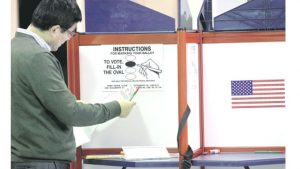
WORCESTER, USA — A voter examines a ballot at an early voting location yesterday in Worcester, Massachusetts. For the first time in Massachusetts, voters can cast their ballots for president before Election Day. Early voting will continue through November 4.
WASHINGTON, DC, United States (AP) — Hillary Clinton appears to be displaying strength in the crucial battleground states of North Carolina and Florida among voters casting ballots before election day, and may also be building an early vote advantage in Arizona and Colorado.
Donald Trump, meanwhile, appears to be holding ground in Ohio, Iowa and Georgia, according to data compiled by The Associated Press. Those are important states for Trump, but not sufficient for him to win the presidency if he loses states like Florida or North Carolina.
“The Trump campaign should be concerned,” said Scott Tranter, co-founder of Optimus, a Republican data analytics firm. His firm’s analysis suggests a “strong final showing for the Clinton campaign” in early voting.
Early voting — by mail or at polling stations — is off to a fast start. More than 5.3 million votes have been cast already, far outpacing the rate for this period in 2012. Balloting is underway in 34 out of 37 early voting states.
In all, more than 46 million people are expected to vote before Election Day — or as much as 40 per cent of all votes cast.
Both parties are encouraging their supporters to vote early. The outcome of those ballots won’t be known until counting begins after polls close on November 8, but some clues are available. Some states report the party affiliations of early voters, as well as breakdowns by race and gender.
The data available represent a small sample of the more than 120 million people who will cast ballots in the presidential election, but a notable one.
A look at early voting trends:
GOOD SIGNS FOR CLINTON: FLORIDA, NORTH CAROLINA, MAINE
The Clinton campaign is looking to build an insurmountable lead in Florida and North Carolina during early voting. If she wins either of those states, she’ll probably be the next president.
Using 2012 as a guidepost, she appears to be in a strong position in early voting.
While Democrats tend to do better in early voting, Republicans usually post an initial lead with mail-in ballots before Democrats surpass them during in-person early voting in mid to late October.
Democrats so far have kept it close with mail-in ballots, giving Clinton a chance to run up the score with in-person early voting. To do that, she’ll need non-whites and young people to turn out near the high levels they did in 2012 for Barack Obama.
In North Carolina, Democrats have moved ahead of Republicans in early voting. Republicans had held a modest lead based on mail-in ballots returned, but that was at a much narrower margin than in 2012, when Mitt Romney narrowly won the state. After in-person voting began on Thursday, Democrats overtook Republicans in overall votes cast.
In Florida, a record 3.1 million people have requested ballots, more than one-third of the total voters in 2012. Democrats have requested almost as many ballots as Republicans: 39 per cent vs 40 per cent.
By comparison, in 2008, Republicans held a lead of 49 per cent to 32 per cent in requests, according to an analysis for
AP by Catalist, a Democratic analytical firm. Obama won in Florida in 2008 and 2012.
Democrats are also showing momentum in the second Congressional district of both Maine and Nebraska. The two states allocate electoral votes by congressional district.
Early voting is surging in Arizona, another state Trump can’t afford to lose. Arizona has long been reliably Republican, but Clinton is targeting it.
More than 1.9 million ballots have been requested and 36,000 returned. That’s more than triple the 10,800 ballots returned during a similar period in 2012.
Democrats have a 44 per cent to 31 per cent lead over Republicans in ballots returned. Another 25 per cent were independent or unknown. At this point in 2012, Democrats had a narrower 38 per cent to 35 per cent lead, according to Catalist.
While figures are preliminary, Tranter, the Republican analyst, said Arizona had become competitive.
“It’s close,” Tranter said.
In Colorado, which began voting by mail last week Monday, Democrats led 43 per cent to 30 per cent among the 15,280 ballots returned by late Thursday. In 2012, the party had trailed Republicans early. Registered Democrats have since surpassed Republicans in the state.
And in Nevada, which also began absentee voting this week, overall ballot requests and returns were down. There were sharper declines among older whites, who tend to vote Republican.
GOOD SIGNS FOR TRUMP: OHIO, IOWA AND GEORGIA
Early vote data for now point to potential Trump strength in Ohio, Iowa and Georgia.
In Ohio, data compiled by Michael McDonald, a University of Florida professor who runs the US Elections Project, continue to show big declines in ballot requests in the heavily Democratic counties of Cuyahoga and Franklin.
The state does not break down ballots by party affiliation. By race, voter modelling by Catalist found the white share of Ohio ballot requests was up, to 91 per cent from 88 per cent. The black share declined from 10 per cent to seven per cent.
In Georgia, which also does not report party affiliation, both ballot requests and returns from black voters also trailed 2012 levels.
And in Iowa, Democrats lead early requests, 43 per cent to 36 per cent. But that level is down significantly from 2012. Obama won the state that year based on a strong early vote in his favour.
In a statement, the Republican National Committee said it was focused on boosting turnout in 11 battleground states and predicted a strong election day performance.
“Democrats are not turning out new voters, just turning out people who would have voted on election day,” it said.
